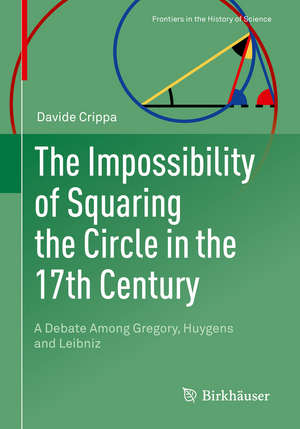The Impossibility of Squaring the Circle in the 17th Century: A Debate Among Gregory, Huygens and Leibniz: Frontiers in the History of Science
Autor Davide Crippaen Limba Engleză Paperback – 19 mar 2019
The author shows how the controversy around the possibility of solving the quadrature of the circle by certain means (algebraic curves) pointed to metamathematical issues, particularly to the completeness of algebra with respect to geometry. In other words, the question underlying the debate on the solvability of the circle-squaring problem may be thus phrased: can finite polynomial equations describe any geometrical quantity? As the study reveals, this question was central in the early days of calculus, when transcendental quantities and operations entered the stage.Undergraduate and graduate students in the history of science, in philosophy and in mathematics will find this book appealing as well as mathematicians and historians with broad interests in the history of mathematics.
Preț: 356.49 lei
Nou
Puncte Express: 535
Preț estimativ în valută:
68.22€ • 72.94$ • 56.88£
68.22€ • 72.94$ • 56.88£
Carte tipărită la comandă
Livrare economică 17 aprilie-01 mai
Preluare comenzi: 021 569.72.76
Specificații
ISBN-13: 9783030016371
ISBN-10: 3030016374
Pagini: 186
Ilustrații: VIII, 184 p. 32 illus., 29 illus. in color.
Dimensiuni: 168 x 240 mm
Greutate: 0.45 kg
Ediția:1st ed. 2019
Editura: Springer International Publishing
Colecția Birkhäuser
Seria Frontiers in the History of Science
Locul publicării:Cham, Switzerland
ISBN-10: 3030016374
Pagini: 186
Ilustrații: VIII, 184 p. 32 illus., 29 illus. in color.
Dimensiuni: 168 x 240 mm
Greutate: 0.45 kg
Ediția:1st ed. 2019
Editura: Springer International Publishing
Colecția Birkhäuser
Seria Frontiers in the History of Science
Locul publicării:Cham, Switzerland
Cuprins
FM.-Introduction.- James Gregory and the Impossibility of Squaring the Central Conic Sections.- Leibniz's Arithmetical Quadrature of the Circle.- Conclusion.-BM.
Recenzii
“This is a highly commendable book about a neglected aspect of a popular story. … Crippa’s book deepens our understanding of the 17th-century discussions about the impossibility (and possibility) of the quadrature of the circle. … Crippa gives an important novel view of Descartes’ problem-solving paradigm and its subsequent extension as well as of the beginning of infinitesimal calcu-lus. Everyone interested in these matters should read Crippa’s well-written book.” (Jesper Lützen, Historia Mathematica, Vol. 52, 2020)
“This book, we are told, is an “abridged and improved” version of the author’s doctoral dissertation, and, in fact, it does read something like a doctoral dissertation: very scholarly and thorough, replete with copious and often lengthy footnotes … . people with a serious interest in the history of science or mathematics will want a copy of this book on their shelves. Any good university library will as well.” (Mark Hunacek, MAA Reviews, June 03, 2019)
Textul de pe ultima copertă
This book is about James Gregory’s attempt to prove that the quadrature of the circle, the ellipse and the hyperbola cannot be found algebraically. Additonally, the subsequent debates that ensued between Gregory, Christiaan Huygens and G.W. Leibniz are presented and analyzed. These debates eventually culminated with the impossibility result that Leibniz appended to his unpublished treatise De quadratura arithmetica.
The author shows how the controversy around the possibility of solving the quadrature of the circle by certain means (algebraic curves) pointed to metamathematical issues, particularly to the completeness of algebra with respect to geometry. In other words, the question underlying the debate on the solvability of the circle-squaring problem may be thus phrased: can finite polynomial equations describe any geometrical quantity? As the study reveals, this question was central in the early days of calculus, when transcendental quantities and operations entered the stage.
Undergraduate and graduate students in the history of science, in philosophy and in mathematics will find this book appealing as well as mathematicians and historians with broad interests in the history of mathematics.
The author shows how the controversy around the possibility of solving the quadrature of the circle by certain means (algebraic curves) pointed to metamathematical issues, particularly to the completeness of algebra with respect to geometry. In other words, the question underlying the debate on the solvability of the circle-squaring problem may be thus phrased: can finite polynomial equations describe any geometrical quantity? As the study reveals, this question was central in the early days of calculus, when transcendental quantities and operations entered the stage.
Undergraduate and graduate students in the history of science, in philosophy and in mathematics will find this book appealing as well as mathematicians and historians with broad interests in the history of mathematics.
Caracteristici
Delivers an unprecedented perspective on this topic Gives a fresh picture of the mathematics in the 17th Century based on previously unstudied documents Conveys mathematics with minimal technical requirements and thorough explanation so that the narrative can be followed by graduate and undergraduate students in sciences and humanities




